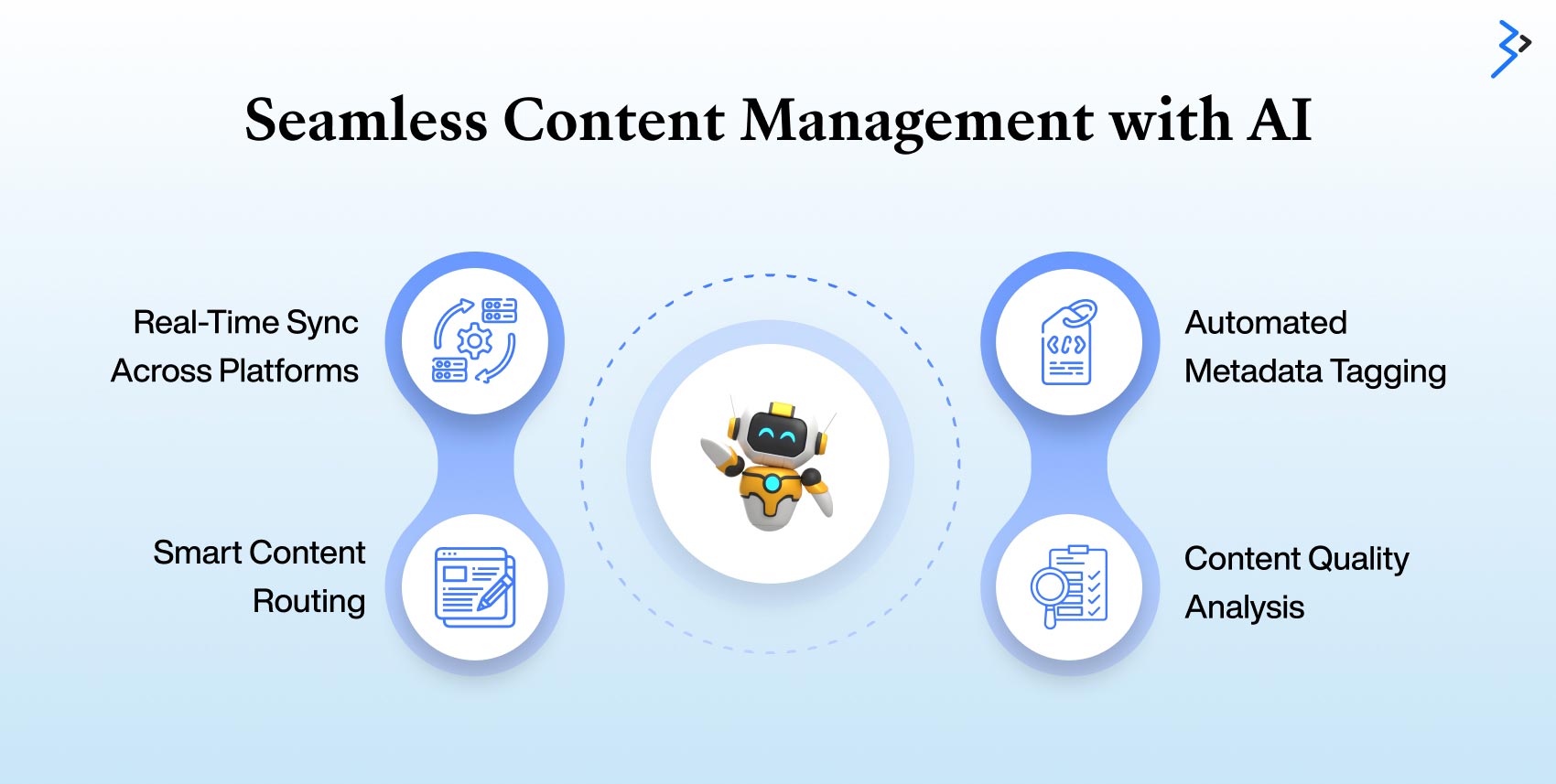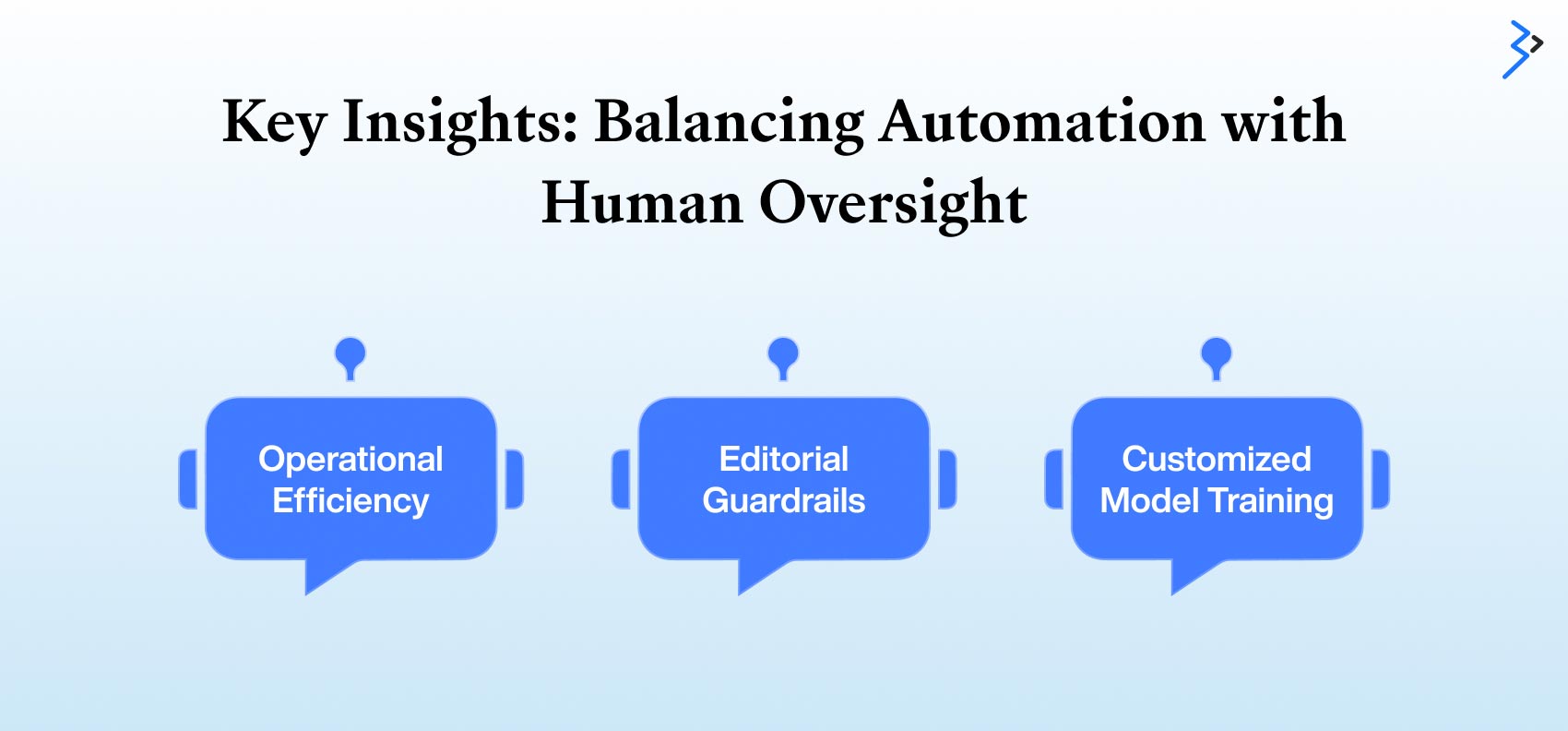Table of contents
Leveraging Large Language Models (LLMs) for Content Generation
Case Study: Home Goods Retailer Triples Product Upload Velocity
Maintaining Brand Voice Through Prompt Engineering and Moderation
Integrating LLMs with PIM and DAM Systems
Key Insights: Balancing Automation with Human Oversight
Impact: Accelerating Time-to-Market and Enhancing SEO
Innovation Beyond Automation: Personalization and Global Reach
AI Virtual Assistants: Redefining Store Management
Looking Ahead: Agentic AI and the Rise of Autonomy
Success Story: Enhancing Medical Support with AI Chatbots
Conclusion: Embracing the Future of Retail Content Creation
In the ever-evolving world of retail, product lines grow rapidly, and customer expectations never stand still. Shoppers want clear, compelling information—and they want it now. That means retailers must deliver engaging product descriptions, search-friendly copy, and eye-catching image captions that inform and inspire action.
But producing all this content manually? It’s a slow, resource-heavy process. As new products launch, teams struggle to keep up, causing delays in time-to-market and an inconsistent brand voice across platforms.
Enter Generative AI—a powerful solution built to meet these challenges head-on. It doesn’t just speed things up; it transforms the way content is created. With AI, retailers can instantly generate tailored, on-brand content that aligns with seo strategies and customer preferences, all without burning out internal teams.
No more racing to meet deadlines or sacrificing quality for speed. Generative AI development brings consistency, creativity, and efficiency into the content pipeline—helping brands stay relevant, responsive, and ready for whatever’s next.
Leveraging Large Language Models (LLMs) for Content Generation
Keeping up with content demands can be overwhelming in today's fast-paced retail environment. That’s where Large Language Models (LLMs) like OpenAI’s GPT step in—revolutionizing how product content is created at scale while maintaining brand quality.
LLMs are trained on vast amounts of text data, enabling them to understand context, brand tone, and customer intent. This makes them an ideal tool for automating content creation while still sounding human and engaging.
Here’s how retailers are benefiting from LLM-powered content generation:
- Product Descriptions: Generate compelling, benefit-driven copy showcasing product features and meeting customer needs.
- SEO-Optimized Copy: Craft keyword-rich descriptions and meta content that improve search engine rankings and boost discoverability.
- Image Captions: Create catchy, on-brand captions that bring visual content to life and drive engagement.
Key Benefits of Integrating LLMs into Content Workflows:

- Faster time-to-market – Launch products quickly with instant content generation.
- Consistency at scale – Maintain a unified brand voice across hundreds (or thousands) of SKUs.
- More time for strategy – Free up creative teams to focus on big-picture marketing.
- Multilingual content – Translate and localize content for global audiences in minutes.
By automating repetitive writing tasks, LLMs empower retailers to scale their content operations without sacrificing quality. The result? Richer product pages, better SEO, and a more compelling customer experience—delivered faster than ever before.
Read More - AI-Powered Enhancements: How Shopify’s AI Revolution is Transforming eCommerce
Case Study: Home Goods Retailer Triples Product Upload Velocity
A well-known B2C home goods supplier faced a common challenge in retail: delays in product uploads due to time-consuming, manual content creation and inefficient workflows. Seeking to speed up operations and reduce costs, the company implemented advanced operational visibility tools to gain better control over its product management process.
The impact was immediate and measurable:
- Product upload velocity tripled
- Operational costs reduced by 3x
- More streamlined and coordinated product workflows
While this transformation centered on backend optimization, it highlights a powerful opportunity: integrating Generative AI into content workflows can yield similar—if not greater—benefits on the content side.
Here’s how Generative AI can replicate and extend these gains:
- Automated product descriptions – Launch SKUs faster with instantly generated, high-quality copy.
- Built-in SEO optimization – Enhance discoverability from day one with keyword-rich content.
- Scalable content output – Generate everything from image captions to care instructions in bulk.
- Error reduction – Minimize inconsistencies and manual mistakes across product pages.
By replacing manual tasks with AI-powered content generation, retailers can dramatically increase efficiency and go-to-market speed, just as this home goods retailer did. This case shows that pairing operational tools with Generative AI creates a powerful combination for modern retail success.
Read More - Creating a Simple Chatbot: Shaping the Future of Conversational AI
Maintaining Brand Voice Through Prompt Engineering and Moderation
Automating content creation is powerful, but not without risks. One of the biggest concerns for retailers is losing the distinctive brand voice that customers recognize and trust.
That’s where prompt engineering comes in. Think of it as giving the AI clear, detailed instructions—like a seasoned copywriter’s creative brief. The better the prompt, the more the AI mirrors your tone, values, and messaging.
But we don’t stop there.
Enter moderation layers. These serve as quality control, ensuring that every piece of AI-generated content hits the mark before going live. With the right checks in place, you get scalable content that’s not just fast, but brand-safe.
Here’s how the two work together to protect your brand:
- Prompt Engineering: Custom prompts are designed to reflect your brand’s tone—whether it’s playful, professional, luxurious, or minimal.
- Moderation Layers: Human reviewers and AI filters screen for errors, bias, or off-brand language.
- Iterative Refinement: Feedback loops allow continuous improvement in AI outputs over time.
- Brand Consistency at Scale: Whether it’s five products or five thousand, your voice stays unmistakably yours.
The Takeaway:
- Combine smart prompt engineering with robust moderation for optimal results
- Achieve speed through automation without compromising brand identity
- Go beyond fast content—ensure authenticity in every message
- Maintain consistent tone and style across platforms
- Stay in control of brand voice throughout automated processes
Integrating LLMs with PIM and DAM Systems
In this eCommerce environment, retailers are under immense pressure to launch products faster, maintain consistent brand messaging, and deliver content that resonates across multiple channels.
Integrating Large Language Models (LLMs) with Product Information Management (PIM) and Digital Asset Management (DAM) systems has emerged as a strategic solution to meet these demands with speed, scale, and accuracy.
Seamless Content Management with AI

By connecting LLMs' generative capabilities to PIM and DAM platforms, retailers can automate and streamline the most time-consuming aspects of content operations. This integration empowers content teams to focus on creative strategy rather than manual execution.
Automated Metadata Tagging
LLMs can analyze product descriptions, specifications, and images to generate relevant, SEO-friendly metadata. This enhances content organization, improves searchability within the system, and drives discoverability on eCommerce platforms.
Content Quality Analysis
AI tools can evaluate existing product content for grammar, tone, and structure. They flag inconsistencies and surface improvements to align copy with brand guidelines.
Smart Content Routing
Based on automated content analysis, assets can be routed to the right teams—design, SEO, legal—for review or publication. This ensures content is always in the right hands at the right time.
Real-Time Sync Across Platforms
LLMs integrated with PIM and DAM allow instant updates across websites, marketplaces, and marketing channels, ensuring consistency of content across all customer touchpoints.
Read More - Top AI Workflow Automation Tools
Key Insights: Balancing Automation with Human Oversight

Despite the efficiency gains, retailers must walk a fine line between automation and human judgment. While LLMs are excellent at handling scale and speed, the human touch remains essential for brand authenticity and trust.
- Operational Efficiency: LLMs can handle repetitive and high-volume tasks like product descriptions or translations, freeing creative teams to focus on campaigns, strategy, and innovation.
- Editorial Guardrails: AI-generated content must be reviewed through editorial workflows to maintain voice and trust. Built-in prompts, tone guidelines, and human moderation act as protective layers to maintain brand quality.
- Customized Model Training: Training AI on brand-specific tone, style, and terminology ensures content that sounds authentically "you." LLMs learn from your past product data, marketing copy, and customer interactions to deliver context-aware, relevant output.
Impact: Accelerating Time-to-Market and Enhancing SEO
Let’s examine the compelling reasons why LLM-powered retailers are pulling ahead and how AI is transforming every facet of the eCommerce experience.
Faster Time-to-Market: Strike While the Trend Is Hot
Retailers live or die by timing. In a world where trends move in real-time, getting a product listed within hours instead of days is a game-changer. LLMs enable rapid content creation by automating product descriptions, specs, and metadata.
This gives teams the power to respond instantly to seasonal spikes, viral trends, or inventory changes, without compromising quality. The result? Quicker launches, more agile campaigns, and greater revenue opportunities.
SEO That Works While You Sleep
LLMs are not just fast—they’re smart. These models can generate keyword-rich, high-quality content at scale, boosting organic traffic and search rankings. Paired with automated metadata and structured tagging, retailers see major lifts in visibility across search engines.
This always-on SEO strategy ensures that your products are discoverable even in a crowded marketplace, driving more traffic and conversions.
Brand Voice at Scale: Consistency Without the Headache
Maintaining a consistent tone and brand voice across thousands of SKUs, marketing channels, and customer segments is no small feat. LLMs make this easier by automatically enforcing uniformity in language, tone, and messaging.
Whether you’re describing one product or ten thousand, your brand personality stays intact, improving trust and recognition with your audience.
Read More - Best Gen-AI-Based Customer Service Chatbots
Innovation Beyond Automation: Personalization and Global Reach
Automation is only part of the story. LLMs' real value lies in their ability to understand context and generate content that adapts dynamically to each customer.
Adaptive Content for Every Customer
Imagine a shopper browsing for outdoor gear. Based on their behavior, preferences, and purchase history, an LLM can automatically adjust product descriptions to highlight weatherproofing, compact design, or versatility—whichever matters most to that individual. This level of tailored messaging boosts engagement, improves the shopping experience, and increases the likelihood of conversion.
Speak Their Language—Literally
Scaling globally used to mean hiring localization experts for every region. Now, LLMs can translate and localize content instantly into multiple languages while preserving cultural nuance, tone, and relevance. Whether you’re entering new markets or supporting multilingual audiences at home, AI helps ensure your message lands perfectly every time.
AI Virtual Assistants: Redefining Store Management
AI’s influence doesn’t stop at content. Virtual assistants powered by LLMs are now helping retailers streamline store operations. Shopify’s Sidekick is one prominent example—a smart assistant that empowers merchants to work smarter, not harder.
Superpowers of AI Virtual Assistants
- Deliver real-time sales insights and trend analysis
- Automate repetitive store management tasks
- Assist with inventory, order tracking, and customer communication
- Recommend products and promotions based on shopper behavior
These assistants extend your team’s capabilities, reduce human error, and free up valuable time. Even small teams can operate like larger enterprises, gaining the agility and efficiency needed to stay competitive.
Looking Ahead: Agentic AI and the Rise of Autonomy
We’re on the brink of an even bigger shift—Agentic AI. Unlike traditional LLMs that respond to prompts, Agentic Chatbots AI systems can initiate, plan, and complete tasks with minimal human input. Think of it as AI with a mind of its own—one that learns, evolves, and takes action.
What Makes Agentic AI Revolutionary?
- Executes multi-step workflows autonomously
- Learns from past interactions to improve decision-making
- Manages complex systems like pricing, inventory, and recommendations in real-time
In retail, this means product pages that update themselves based on performance, AI-driven merchandising strategies that optimize on the fly, and fully automated supply chain adjustments. It’s not just about smarter tools—it’s about building self-operating ecosystems that can adapt and thrive independently.
Success Story: Enhancing Medical Support with AI Chatbots
Bay Alarm Medical, a leader in medical alert systems, transformed its customer support experience by integrating an AI-powered chatbot. Designed to handle frequent inquiries, the chatbot was connected to their CRM system, enabling seamless, 24/7 customer assistance.
This shift didn’t just speed up service—it redefined it. Customers received instant support at any time of day, while human agents were freed up to manage complex, emotionally sensitive cases. The result? Happier customers, more efficient teams, and a future-ready support system.
Key Highlights:
- AI chatbot integrated with CRM for real-time, personalized responses
- 24/7 availability dramatically reduced response times
- Freed human agents to focus on complex, high-impact issues
- Boosted customer satisfaction and support team efficiency
- Demonstrated scalable AI potential in the healthcare support space
Bay Alarm Medical’s success shows how AI isn’t just about automation—it’s about elevating human service and meeting critical needs faster and smarter.
Conclusion: Embracing the Future of Retail Content Creation
Generative AI is poised to revolutionize retail content creation, offering solutions to longstanding challenges in efficiency, consistency, and scalability. By thoughtfully integrating AI technologies, retailers can enhance their content strategies, maintain brand integrity, and deliver exceptional customer experiences.
Generative AI will be crucial for retailers to remain competitive and meet the evolving expectations of the digital marketplace.
FAQs
1. How do AI virtual assistants improve the eCommerce customer experience?
AI virtual assistants streamline interactions by offering instant support, answering FAQs, providing personalized product recommendations, and assisting with order tracking, resulting in faster resolutions, higher customer satisfaction, and increased conversions.
2. What role does Generative AI play in eCommerce content creation?
Generative AI automates product descriptions, SEO copy, image captions, and multilingual content. It ensures brand consistency, accelerates time-to-market, and reduces the manual effort required by content teams.
3. Can AI virtual assistants maintain our brand voice?
Yes. Through prompt engineering and moderation layers, AI can generate on-brand content that aligns with your tone and messaging. Human oversight ensures authenticity and consistent quality across platforms.
4. How do LLMs integrate with PIM and DAM systems in retail?
When integrated with Product Information Management (PIM) and Digital Asset Management (DAM) systems, LLMs automate content tagging, analysis, and routing. This ensures fast, organized, and consistent content across all digital touchpoints.
5. What is Agentic AI, and how is it different from traditional virtual assistants?
Agentic AI can independently plan, learn, and act without human prompts. Unlike reactive AI assistants, it autonomously executes complex workflows like inventory management and dynamic pricing, enabling self-optimizing eCommerce operations.
Related Articles
Digital Transformation
Orchestrating Experiences: How AEP Agent Orchestrator Redefines Business Efficiency
Digital Transformation
Beyond the Click: Leveraging Customer Journey Analytics with Adobe Analytics for Deeper Insights
Digital Transformation
AI in Action: Revolutionizing Content Management and Delivery with Adobe Experience Manager Assets



